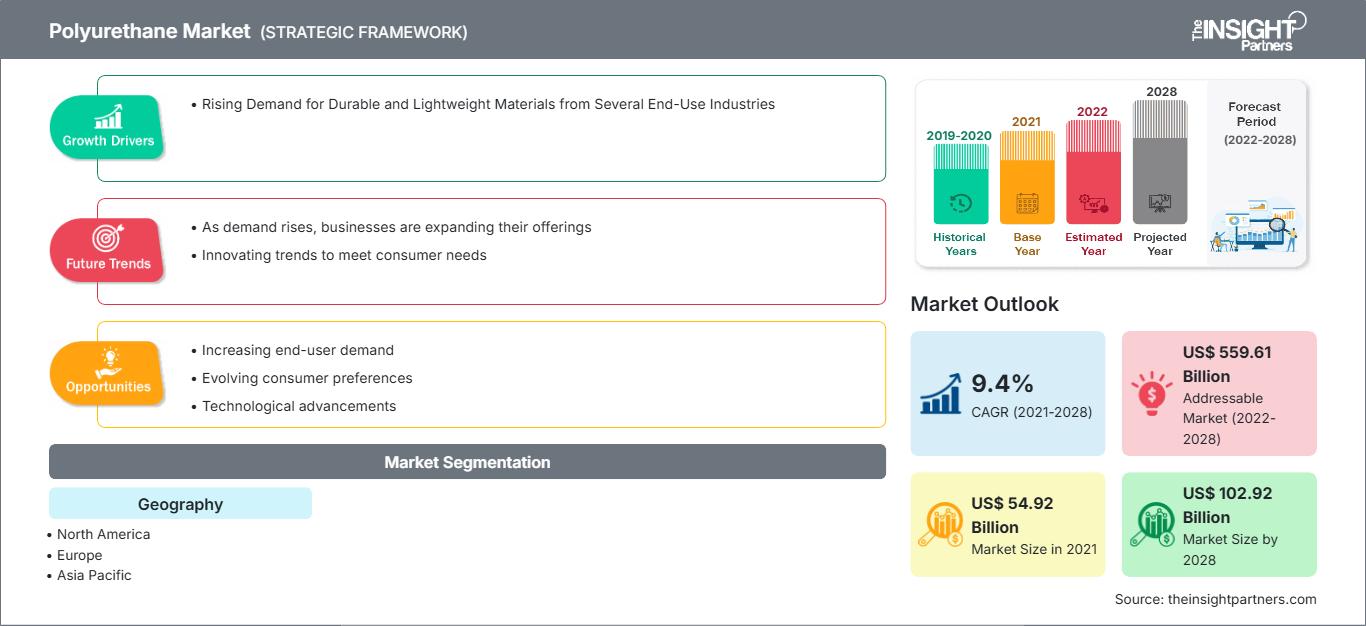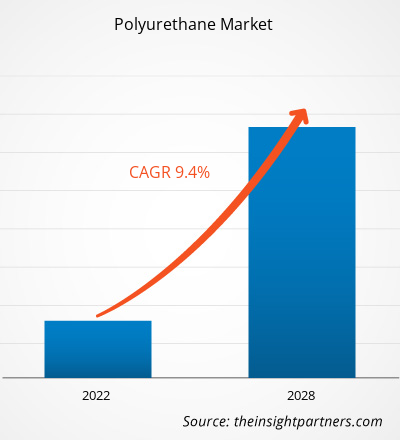[Informe de investigación] El mercado del poliuretano se valoró en 54.917,09 millones de dólares estadounidenses en 2021 y se prevé que alcance los 102.916,80 millones de dólares estadounidenses en 2028; se espera que crezca a una tasa de crecimiento anual compuesta (TCAC) del 9,4% entre 2020 y 2028.
ANÁLISIS DE MERCADO
El poliuretano es un material sintetizado mediante la copolimerización de un isocianato y un alcohol polihídrico. Los compuestos y mezclas de poliuretano tienen amplias aplicaciones en electrónica y optoelectrónica. Sus usos son muy diversos e incluyen sensores, electrolitos, actuadores, blindaje EMI para supercondensadores y baterías, disipación electrostática y aplicaciones de memoria de forma. El mercado potencial para la electrónica impresa es enorme. El poliuretano y sus adhesivos compuestos se utilizan en electrónica flexible e impresa. Los compuestos de encapsulado de poliuretano se formulan específicamente para cumplir con una amplia gama de propiedades físicas, térmicas y eléctricas. Protegen los componentes electrónicos gracias a sus excelentes propiedades aislantes y adhesivas, su excepcional flexibilidad, su resistencia al agua y a la temperatura.
FACTORES DE CRECIMIENTO Y DESAFÍOS
El creciente apoyo gubernamental al desarrollo de infraestructura y el uso cada vez mayor del poliuretano como material aislante a nivel mundial han impulsado el crecimiento del mercado de productos industriales de poliuretano. Los gobiernos de diversos países se centran en el desarrollo de la infraestructura nacional. Este desarrollo abarca proyectos relacionados con carreteras, puertos, ferrocarriles y aeropuertos; proyectos agrícolas y de energías renovables; e infraestructura industrial y social. Según TATA Capital, el Presupuesto 2020 también impulsó el desarrollo de infraestructura para fomentar la inversión en proyectos de carreteras, ferrocarriles, aeropuertos, autopistas y puertos. Con una asignación de más de 1,25 billones de dólares estadounidenses para proyectos de infraestructura, el gobierno indio identificó más de 6.500 proyectos en el marco del Plan Nacional de Infraestructura (NIP, por sus siglas en inglés) para construir una economía de 5 billones de dólares para 2025. Estas iniciativas apoyan al sector de la construcción, principalmente en países en desarrollo, y generarán amplias oportunidades para el mercado del poliuretano en los próximos años. La volatilidad de los precios de las materias primas utilizadas en la fabricación de poliuretano representa un desafío para este mercado. Los fabricantes producen espuma de poliuretano principalmente mediante la reacción de polioles y diisocianatos, ambos derivados del petróleo crudo. Por lo tanto, la volatilidad de los precios del petróleo crudo afecta el costo de producción del poliuretano. Los precios internacionales del petróleo crudo experimentaron incertidumbre en 2020, la cual persiste en 2021. Tanto la demanda como los precios del petróleo crudo cayeron drásticamente en los primeros meses de 2020 debido a los confinamientos y las restricciones de viaje en diversos países del mundo. Los precios del petróleo se desplomaron tanto que el precio del crudo WTI y el precio de referencia del crudo estadounidense llegaron a ser negativos en abril de 2020.
Obtendrá personalización en cualquier informe, sin cargo, incluidas partes de este informe o análisis a nivel de país, paquete de datos de Excel, así como también grandes ofertas y descuentos para empresas emergentes y universidades.
Mercado del poliuretano: Perspectivas estratégicas

- Obtenga las principales tendencias clave del mercado que se describen en este informe.Esta muestra GRATUITA incluirá análisis de datos, desde tendencias del mercado hasta estimaciones y pronósticos.
SEGMENTACIÓN Y ALCANCE DEL INFORME
El informe "Análisis del mercado global del poliuretano hasta 2030" es un estudio especializado y exhaustivo que se centra en las tendencias y oportunidades de crecimiento del mercado global. Su objetivo es ofrecer una visión general del mercado mundial, con una segmentación detallada por materia prima, producto, aplicación y geografía. El mercado global del poliuretano ha experimentado un fuerte crecimiento en los últimos años y se prevé que esta tendencia continúe durante el período de pronóstico. El informe proporciona estadísticas clave sobre el consumo mundial de poliuretano, así como su demanda en las principales regiones y países. Además, ofrece una evaluación cualitativa de los diversos factores que afectan al rendimiento del mercado del poliuretano en las principales regiones y países. El informe también incluye un análisis exhaustivo de los principales actores del mercado del poliuretano y sus principales desarrollos estratégicos. Asimismo, se incluyen varios análisis sobre la dinámica del mercado para ayudar a identificar los principales factores impulsores, las tendencias del mercado y las oportunidades lucrativas que, a su vez, contribuirán a identificar las principales fuentes de ingresos.
Además, el análisis del ecosistema y el análisis de las cinco fuerzas de Porter proporcionan una visión de 360 grados del mercado mundial del poliuretano, lo que ayuda a comprender toda la cadena de suministro y los diversos factores que afectan al crecimiento del mercado.
ANÁLISIS SEGMENTAL
El mercado global del poliuretano se segmenta según la materia prima, el producto y la aplicación. Según la materia prima, se divide en polioles, MDI, TDI y otros. Según el producto, se clasifica en espuma rígida, espuma flexible, recubrimientos, adhesivos, selladores y aglutinantes, elastómeros y otros. En función de la aplicación, se categoriza en mobiliario e interiores, construcción, electrónica y electrodomésticos, automoción, calzado, embalaje y otros. Los polioles, compuestos orgánicos con múltiples grupos hidroxilo, representan una parte significativa del mercado. Se encuentran entre las materias primas clave utilizadas en la producción de poliuretanos. El diisocianato de difenilmetano (MDI) es un compuesto aromático que se utiliza en la producción de poliuretano. Reacciona con los polioles para formar poliuretano. El diisocianato de tolueno (TDI) es un compuesto químico, un líquido transparente de color amarillo pálido o incoloro. Se utiliza para fabricar espumas de poliuretano flexibles, ampliamente empleadas en aplicaciones como colchones y muebles, bases para alfombras y materiales de embalaje. Las materias primas utilizadas para la producción de poliuretanos, además de los polioles y los diisocianatos, son estabilizadores y aditivos. La espuma flexible, por producto, representó la mayor cuota de mercado. Se caracteriza por una estructura celular que permite cierto grado de compresión y, a la vez, cierta resiliencia, lo que proporciona un efecto de amortiguación. Gracias a esta propiedad, es un material muy utilizado en muebles, equipamiento deportivo, embalaje, calzado, ropa de cama, asientos de automóviles y relleno de alfombras. Además, desempeña un papel importante en el aislamiento acústico y la filtración. La espuma de poliuretano rígida es conocida por ser uno de los materiales aislantes más eficientes y de alto rendimiento; además, permite un ahorro energético muy efectivo con una mínima ocupación de espacio.
ANÁLISIS REGIONAL
El informe ofrece una visión general detallada del mercado mundial del poliuretano en cinco regiones principales: Norteamérica, Europa, Asia-Pacífico (APAC), Oriente Medio y África (MEA) y Sudamérica y Centroamérica. Asia-Pacífico representó una parte significativa del mercado, valorado en más de 9.500 millones de dólares estadounidenses en 2022. Los países emergentes de Asia-Pacífico están experimentando un auge en la urbanización y la industrialización, lo que ofrece amplias oportunidades para los principales actores del mercado del poliuretano. Países como Australia, Japón, India, China, Corea del Sur, Singapur, Taiwán e Indonesia cuentan con importantes industrias manufactureras en diversos sectores, como el químico, el textil, el automotriz, el electrónico, entre otros. El sector manufacturero en estos países ha experimentado una gran transformación a lo largo de los años. El mercado de poliuretano en Norteamérica se valoró en más de 3.500 millones de dólares estadounidenses en 2022. Este mercado está creciendo debido a la creciente demanda de las industrias del mueble y la decoración de interiores, la construcción, la electrónica y los electrodomésticos, la automoción, el calzado, el embalaje y otras industrias ubicadas en Norteamérica.
DESARROLLOS DE LA INDUSTRIA Y OPORTUNIDADES FUTURAS
El informe ofrece una visión general detallada del mercado mundial del poliuretano con respecto a cinco regiones principales: América del Norte, Europa, Asia-Pacífico (APAC), Oriente Medio y África (MEA) y América del Sur y Central.
En 2021, Covestro completó con éxito la adquisición del negocio de resinas y materiales funcionales de DSM.
En 2020, Huntsman Corporation anunció que había renombrado su negocio líder mundial de espuma de poliuretano proyectada (SPF) como Huntsman Building Solutions (HBS). HBS es una plataforma global dentro de la división de Poliuretanos de Huntsman.
Perspectivas regionales del mercado del poliuretano
Los analistas de The Insight Partners han explicado en detalle las tendencias y los factores regionales que influyen en el mercado del poliuretano durante el período de previsión. Esta sección también analiza los segmentos del mercado del poliuretano y su distribución geográfica en Norteamérica, Europa, Asia Pacífico, Oriente Medio y África, y Sudamérica y Centroamérica.
Alcance del informe de mercado del poliuretano
| Atributo del informe | Detalles |
|---|---|
| Tamaño del mercado en 2021 | 54.920 millones de dólares estadounidenses |
| Tamaño del mercado para 2028 | US$ 102.92 mil millones |
| Tasa de crecimiento anual compuesto global (2021 - 2028) | 9,4% |
| Datos históricos | 2019-2020 |
| período de previsión | 2022-2028 |
| Regiones y países cubiertos | América del norte
|
| Líderes del mercado y perfiles de empresas clave |
|
Densidad de los actores del mercado del poliuretano: comprensión de su impacto en la dinámica empresarial
El mercado del poliuretano está creciendo rápidamente, impulsado por la creciente demanda de los usuarios finales debido a factores como la evolución de las preferencias de los consumidores, los avances tecnológicos y una mayor conciencia de los beneficios del producto. A medida que aumenta la demanda, las empresas amplían su oferta, innovan para satisfacer las necesidades de los consumidores y aprovechan las nuevas tendencias, lo que impulsa aún más el crecimiento del mercado.

- Obtenga una visión general de los principales actores del mercado del poliuretano.
IMPACTO DEL COVID/IMPACTO DEL ESCENARIO GEOPOLÍTICO/IMPACTO DE LA RECESIÓN
El informe ofrece una visión general detallada del mercado mundial del poliuretano en cinco regiones principales: Norteamérica, Europa, Asia-Pacífico (APAC), Oriente Medio y África (MEA) y Sudamérica y Centroamérica. Sectores como la construcción, la automoción, la electrónica y el mobiliario han sido los principales consumidores de poliuretano. En 2020, estos sectores tuvieron que ralentizar sus operaciones debido a las interrupciones en la cadena de valor provocadas por el cierre de fronteras nacionales e internacionales. Además, los confinamientos impuestos por diferentes países dificultaron la capacidad de las industrias para mantener los niveles de inventario ese mismo año. La escasez de mano de obra provocó una desaceleración en la producción y distribución de poliuretano. Asimismo, las restricciones gubernamentales y otras medidas de precaución contra la COVID-19 redujeron la capacidad de producción de los actores del ecosistema del poliuretano. En 2021, el mercado mundial comenzó a recuperarse de las pérdidas sufridas en 2020, ya que los gobiernos de diferentes países anunciaron la flexibilización de las restricciones sociales. Además, se prevé la reanudación de los proyectos de construcción previamente aplazados, lo que brindará a los participantes del mercado del poliuretano la oportunidad de recuperar la normalidad. La expansión de las capacidades de producción en la industria química y de materiales en diferentes regiones del mundo provocó un aumento de la demanda de poliuretano en 2021.
PANORAMA COMPETITIVO Y EMPRESAS CLAVE
Algunos de los principales actores y fabricantes de poliuretano que operan en el mercado de poliuretano incluyen a Covestro AG, FXI, Huntsman Corporation, Lubrizol Corporation, Mitsui Chemicals Inc, BASF SE, The Dow Chemical Company, DIC Corporation, Recticel NV y Tosoh Corporation, entre otros.
- Análisis histórico (2 años), año base, pronóstico (7 años) con CAGR
- Análisis PEST y FODA
- Tamaño del mercado, valor/volumen: global, regional y nacional
- Industria y panorama competitivo
- Conjunto de datos de Excel
Informes recientes
Testimonios
Razón para comprar
- Toma de decisiones informada
- Comprensión de la dinámica del mercado
- Análisis competitivo
- Información sobre clientes
- Pronósticos del mercado
- Mitigación de riesgos
- Planificación estratégica
- Justificación de la inversión
- Identificación de mercados emergentes
- Mejora de las estrategias de marketing
- Impulso de la eficiencia operativa
- Alineación con las tendencias regulatorias




















 Obtenga una muestra gratuita para - Mercado del poliuretano
Obtenga una muestra gratuita para - Mercado del poliuretano